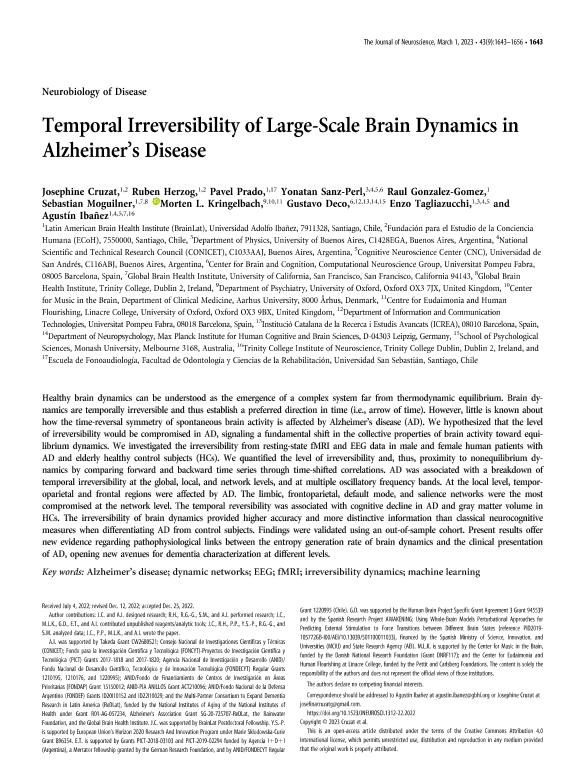Mostrar el registro sencillo del ítem
dc.contributor.author
Cruzat, Josephine
dc.contributor.author
Herzog, Ruben
dc.contributor.author
Prado, Pavel
dc.contributor.author
Sanz Perl Hernandez, Yonatan

dc.contributor.author
Gonzalez Gomez, Raul
dc.contributor.author
Moguilner, Sebastian Gabriel

dc.contributor.author
Kringelbach, Morten L.
dc.contributor.author
Deco, Gustavo
dc.contributor.author
Tagliazucchi, Enzo Rodolfo

dc.contributor.author
Ibañez, Agustín
dc.date.available
2024-02-26T15:54:20Z
dc.date.issued
2023-03
dc.identifier.citation
Cruzat, Josephine; Herzog, Ruben; Prado, Pavel; Sanz Perl Hernandez, Yonatan; Gonzalez Gomez, Raul; et al.; Temporal Irreversibility of Large-Scale Brain Dynamics in Alzheimer's Disease; Society for Neuroscience; Journal of Neuroscience; 43; 9; 3-2023; 1643-1656
dc.identifier.issn
0270-6474
dc.identifier.uri
http://hdl.handle.net/11336/228444
dc.description.abstract
Healthy brain dynamics can be understood as the emergence of a complex system far from thermodynamic equilibrium. Brain dynamics are temporally irreversible and thus establish a preferred direction in time (i.e., arrow of time). However, little is known about how the time-reversal symmetry of spontaneous brain activity is affected by Alzheimer's disease (AD). We hypothesized that the level of irreversibility would be compromised in AD, signaling a fundamental shift in the collective properties of brain activity toward equilibrium dynamics. We investigated the irreversibility from resting-state fMRI and EEG data in male and female human patients with AD and elderly healthy control subjects (HCs). We quantified the level of irreversibility and, thus, proximity to nonequilibrium dynamics by comparing forward and backward time series through time-shifted correlations. AD was associated with a breakdown of temporal irreversibility at the global, local, and network levels, and at multiple oscillatory frequency bands. At the local level, temporoparietal and frontal regions were affected by AD. The limbic, frontoparietal, default mode, and salience networks were the most compromised at the network level. The temporal reversibility was associated with cognitive decline in AD and gray matter volume in HCs. The irreversibility of brain dynamics provided higher accuracy and more distinctive information than classical neurocognitive measures when differentiating AD from control subjects. Findings were validated using an out-of-sample cohort. Present results offer new evidence regarding pathophysiological links between the entropy generation rate of brain dynamics and the clinical presentation of AD, opening new avenues for dementia characterization at different levels.
dc.format
application/pdf
dc.language.iso
eng
dc.publisher
Society for Neuroscience

dc.rights
info:eu-repo/semantics/openAccess
dc.rights.uri
https://creativecommons.org/licenses/by-nc-sa/2.5/ar/
dc.subject
ALZHEIMER'S DISEASE
dc.subject
DYNAMIC NETWORKS
dc.subject
EEG
dc.subject
FMRI
dc.subject
IRREVERSIBILITY DYNAMICS
dc.subject
MACHINE LEARNING
dc.subject.classification
Otras Ciencias Físicas

dc.subject.classification
Ciencias Físicas

dc.subject.classification
CIENCIAS NATURALES Y EXACTAS

dc.title
Temporal Irreversibility of Large-Scale Brain Dynamics in Alzheimer's Disease
dc.type
info:eu-repo/semantics/article
dc.type
info:ar-repo/semantics/artículo
dc.type
info:eu-repo/semantics/publishedVersion
dc.date.updated
2024-02-26T11:11:05Z
dc.identifier.eissn
1529-2401
dc.journal.volume
43
dc.journal.number
9
dc.journal.pagination
1643-1656
dc.journal.pais
Estados Unidos

dc.description.fil
Fil: Cruzat, Josephine. Fundación Para El Estudio de la Conciencia Humana; Chile. Universidad Adolfo Ibañez; Chile
dc.description.fil
Fil: Herzog, Ruben. Fundación Para El Estudio de la Conciencia Humana; Chile. Universidad Adolfo Ibañez; Chile
dc.description.fil
Fil: Prado, Pavel. Fundación Para El Estudio de la Conciencia Humana; Chile. Universidad Adolfo Ibañez; Chile
dc.description.fil
Fil: Sanz Perl Hernandez, Yonatan. Universidad de Buenos Aires; Argentina. Universidad de San Andrés; Argentina. Universitat Pompeu Fabra; España. Consejo Nacional de Investigaciones Científicas y Técnicas; Argentina
dc.description.fil
Fil: Gonzalez Gomez, Raul. Universidad Adolfo Ibañez; Chile
dc.description.fil
Fil: Moguilner, Sebastian Gabriel. Universidad Adolfo Ibañez; Chile. Trinity College Dublin; Irlanda. University of California; Estados Unidos
dc.description.fil
Fil: Kringelbach, Morten L.. University Aarhus; Dinamarca. University of Oxford; Reino Unido
dc.description.fil
Fil: Deco, Gustavo. Universitat Pompeu Fabra; España. Monash University; Australia. Max Planck Institute For Human Cognitive And Brain Sciences; Alemania. Institució Catalana de Recerca I Estudis Avançats; España
dc.description.fil
Fil: Tagliazucchi, Enzo Rodolfo. Universidad de San Andrés; Argentina. Universidad de Buenos Aires; Argentina. Consejo Nacional de Investigaciones Científicas y Técnicas; Argentina. Universidad Adolfo Ibañez; Chile
dc.description.fil
Fil: Ibañez, Agustín. Trinity College Dublin; Irlanda. Universidad Adolfo Ibañez; Chile. Universidad de San Andrés; Argentina. Consejo Nacional de Investigaciones Científicas y Técnicas; Argentina. University of California; Estados Unidos
dc.journal.title
Journal of Neuroscience

dc.relation.alternativeid
info:eu-repo/semantics/altIdentifier/doi/http://dx.doi.org/10.1523/JNEUROSCI.1312-22.2022
dc.relation.alternativeid
info:eu-repo/semantics/altIdentifier/url/https://www.jneurosci.org/content/43/9/1643
Archivos asociados
